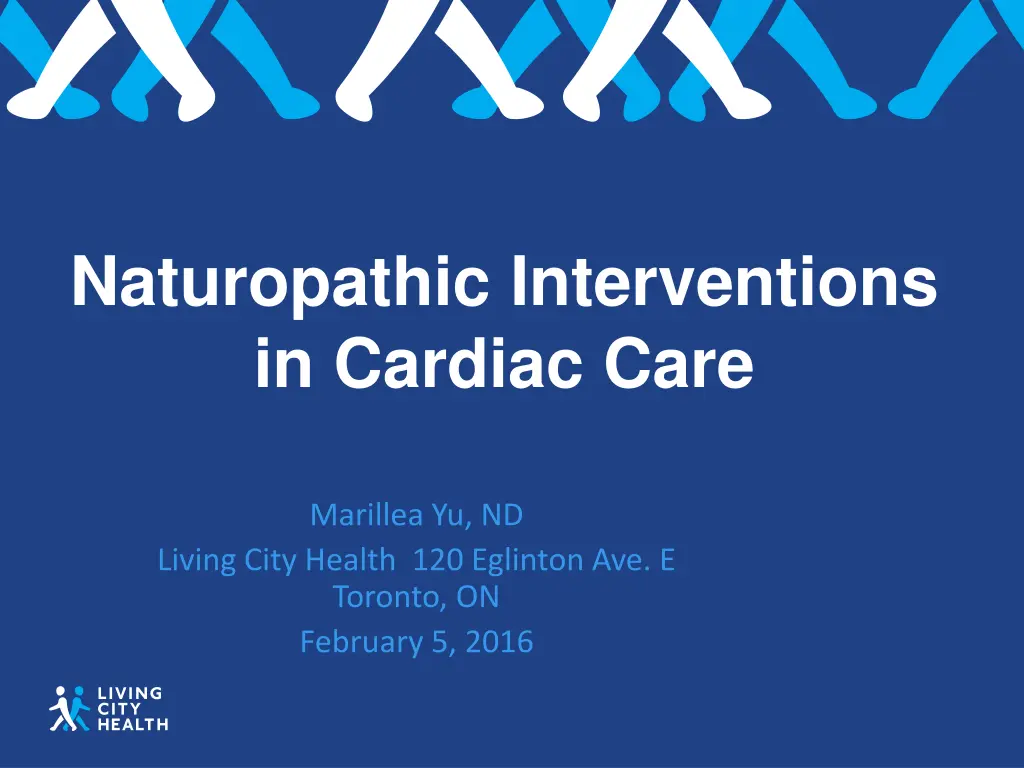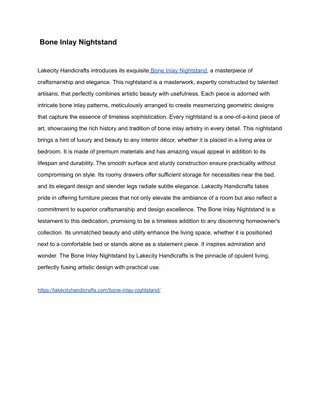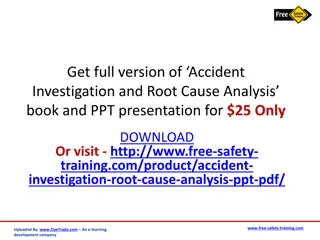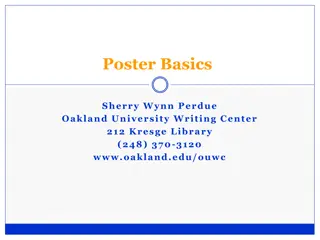
Naturopathic Interventions in Cardiac Care by Dr. Marillea Yu, ND
Explore naturopathic interventions in cardiac care presented by Dr. Marillea Yu, ND, focusing on prevention, managing nutrient depletions, enhancing quality of life, and reducing reliance on pharmaceuticals. Learn about CAM use among Canadians, evidence-based methodologies, and specific interventions like magnesium, PUFAs, CoQ10, and more for cardiac health.
Download Presentation

Please find below an Image/Link to download the presentation.
The content on the website is provided AS IS for your information and personal use only. It may not be sold, licensed, or shared on other websites without obtaining consent from the author. If you encounter any issues during the download, it is possible that the publisher has removed the file from their server.
You are allowed to download the files provided on this website for personal or commercial use, subject to the condition that they are used lawfully. All files are the property of their respective owners.
The content on the website is provided AS IS for your information and personal use only. It may not be sold, licensed, or shared on other websites without obtaining consent from the author.
E N D
Presentation Transcript
Naturopathic Interventions in Cardiac Care Marillea Yu, ND Living City Health 120 Eglinton Ave. E Toronto, ON February 5, 2016
Presenter Disclosure Presenter: Dr. Marillea Yu, ND Relationships with Commercial Interests: Naturopathic Doctor at Living City Health Dr. Marillea Yu, ND Living City Health
Goals of Naturopathic Intervention Prevention of illness and disease Manage nutrient depletions Improve quality of life Ensure safety in integrative care Reduce requirements for pharmaceuticals Dr. Marillea Yu, ND Living City Health
CAM & Your Patients Do you have patients who use CAM (Naturopathy, Chiropractic, Acupuncture, Massage Therapy, etc)? 1) Yes 2) No 3) I don t know Dr. Marillea Yu, ND Living City Health
CAM Use Among Canadians (1) 12.4% of Canadians visited a CAM practitioner in the last 12 months (study prior to 2010) Services typically used in conjunction with with conventional care Less than 60% discussed with primary care MD Most common reason: CAM allowed them to take a more active role in their health Dr. Marillea Yu, ND Living City Health
Evidence-Based Methodology Nutrition Diet recommendations Nutritional supplementation Phytotherapy (Botanical/Herbal Medicine) Acupuncture Mind-Body & Lifestyle Dr. Marillea Yu, ND Living City Health
Naturopathic Interventions Magnesium PUFAs (Omega-3) Vitamin C & E CoQ10 L-Carnitine Hawthorn (Crataegus spp.) Dr. Marillea Yu, ND Living City Health
Which is the most accurate method of measuring intracellular Mg? A) Erythrocyte levels B) Serum levels C) Lymphocyte levels Dr. Marillea Yu, ND Living City Health
Magnesium Depletion associated with arrhythmias, CHF, cardiac arrest(2) Acts as a natural CCB(9), benefits in HTN(5) Reduces density of PVC and SVC, improves symptoms (4), with K+ improves cardioversion(6) Torsades de Pointes, intractable VT (7,9) Improves endothelial function (9) Adjunct to antiarrhythmic agents (3,8) Reduction in post-op afib(10) Dr. Marillea Yu, ND Living City Health
No benefit with Mg High dose IV- intraoperative; no effect on post-op afib after cardiac surgery (11) Intraoperatively- did not reduce incidence of SVA in thoracotomy; did reduce incidence of SVA in pneumonectomy (12) Dr. Marillea Yu, ND Living City Health
Mg administration Oral dosing: 200mg-2000mg daily Intravenous: usually added to other nutrients 500-2000 mg over a period of 5-45 min, depending on dose 1.9-12.0 mg over 20-72 hours- in acute MI Adverse effects: GI irritation, diarrhea, hypotension, bradycardia, arrhythmia Skin flushing, diaphoresis, hypocalcemia, respiratory depression Dr. Marillea Yu, ND Living City Health
Essential Fatty Acids Discovered to be essential in the 1930 s by Dr. George and Mildred Burr Fats were believed to contribute only calories Rats fed a fat-free diet developed poor health and eventually died A few drops of linoleic acid could prevent death in the rats Burr, G. O. Prog. Lipid Res. 20, xxv-xxvi (1981) Dr. Marillea Yu, ND Living City Health
Omega-3 Improved endothelial function, antiarrhythmic (13) Reduced incidence in post-op afib(14,17,19) & recurrent afib (20) Improved outcome in combination with antioxidants (15) Reduced risk of fatal CHD, sudden death(16) Maintaining SR post-cardioversion(19) Dr. Marillea Yu, ND Living City Health
No benefit with Omega-3 Increased risk of post-op atrial fibrillation (21, 22) No benefit in recurrent afib (22,23,25) Heterogeneity in populations studied, use of medication confounding factors, more studies required (24,25) Dr. Marillea Yu, ND Living City Health
Omega-3: Dose & Adverse Effects Dose: 2-4 g Adverse effects: GI disturbance: nausea, loose stool, stomach upset Fishy repeat Allergic reaction > 3g per day may increase bleeding risk Dr. Marillea Yu, ND Living City Health
Antioxidant Vitamins C & E: Reduction in post-op afib in conjunction with n-3 PUFAs compared to placebo (15,26) Decreased levels of biomarkers of oxidative stress and inflammation (26,27) Vit C: reduced incidence of postCABG AF and reduced hospital stay, decreased time to conversion to SR (28) Reduced POAF(29) Well-tolerated Dr. Marillea Yu, ND Living City Health
CoQ10(Ubiquinol/Ubiquinone)(30) Well tolerated Less likely to require ionotropic drugs post- surgery Reduced incidence of ventricular arrhythmia post-surgery No difference in atrial fibrillation No difference in hospital stay duration Heterogeneity across studies Dr. Marillea Yu, ND Living City Health
L-Carnitine(31) Secondary prevention of CVD Reduction in all-cause mortality Reduction in ventricular arrhythmia Reduction in development of angina Dr. Marillea Yu, ND Living City Health
Hawthorn (Crataegus spp.)(32,33,34) Antioxidant activity Positive inotropic effect Antiarrhythmic effect Well-tolerated 4-8 weeks for benefits (160-1800 mg) No reported drug interactions Dr. Marillea Yu, ND Living City Health
Crataegus Dosing: 160-900mg CHF; 1200 mg for HTN Theoretical drug interactions: Digoxin, Beta-blockers, Ca+ channel blockers Nitrates, phosphodiesterase-5 inhibitors Generally well tolerated at recommended dosages Dr. Marillea Yu, ND Living City Health
Conclusion Nutrient status can affect cardiac health Benefits of non-pharmaceutical intervention: Prophylaxis or adjunctively- improvement in conventional outcome May reduce need for higher doses of medication May reduce frequency of intervention Can be well tolerated Benefits in other areas of health Dr. Marillea Yu, ND Living City Health
Thank You Marillea Yu, ND Living City Health 120 Eglinton Ave. E Toronto, ON M4P 1E2 (647)-497-9797 hello@livingcityhealth.com Dr. Marillea Yu, ND Living City Health
References 1. Brenyo A, Aktas M. Review of Complementary and Alternative Medical Treatment of Arrhythmias. The American Journal of Cardiology. 2014;113(5):897-903. 2. Del Gobbo L, Imamura F, Wu J, de Oliveira Otto M, Chiuve S, Mozaffarian D. Circulating and dietary magnesium and risk of cardiovascular disease: a systematic review and meta-analysis of prospective studies. American Journal of Clinical Nutrition. 2013;98(1):160-173. 3. Ganga H, Noyes A, White C, Kluger J. Magnesium Adjunctive Therapy in Atrial Arrhythmias. Pacing and Clinical Electrophysiology. 2013;:n/a-n/a. 4. Falco C, Grupi C, Sosa E, Scanavacca M, Hachul D, Lara S et al. Redu o da densidade de extrass stoles e dos sintomas relacionados ap s administra o de magn sio por via oral. Arq Bras Cardiol. 2012;98(6):480- 487. 5. Houston M. The Role of Magnesium in Hypertension and Cardiovascular Disease. The Journal of Clinical Hypertension. 2011;13(11):843-847. 6. Sultan A, Steven D, Rostock T, Hoffman B, Mullerleile K, Servatius H et al. Intravenous Administration of Magnesium and Potassium Solution Lowers Energy Levels and Increases Success Rates Electrically Cardioverting Atrial Fibrillation. Journal of Cardiovascular Electrophysiology. 2011;23(1):54-59. Dr. Marillea Yu, ND Living City Health
7. El-Sherif N, Turritto G. Electrolyte disorders and arrhythmogenesis. Cardiology Journal. 2011;3(18):233-45. 8. Patsilinakos S, Christou A, Kafkas N, Nikolaou N, Antonatos D, Katsanos S et al. Effect of High Doses of Magnesium on Converting Ibutilide to a Safe and More Effective Agent. The American Journal of Cardiology. 2010;106(5):673-676. 9. Schechter M. Magnesium and cardiovascular system. Magnesium Research. 2010;2(23):60-72. 10. Bakhsh M, Abbas S, Hussain R, Ali Khan S, Naqvi S. Role of magnesium in preventing post-operative atrial fibrillation after coronary artery bypass. Journal of Ayub Medical College, Abbottabad. 2009;2(21):27-9. 11. Klinger R, Thunberg C, White W, Fontes M, Waldron N, Piccini J et al. Intraoperative Magnesium Administration Does Not Reduce Postoperative Atrial Fibrillation After Cardiac Surgery. Anesthesia & Analgesia. 2015;121(4):861-867. 12. Saran T, Perkins G, Javed M, Annam V, Leong L, Gao F et al. Does the prophylactic administration of magnesium sulphate to patients undergoing thoracotomy prevent postoperative supraventricular arrhythmias? A randomized controlled trial. British Journal of Anaesthesia. 2011;106(6):785-791. 13. Jain A, Aggarwal K, Zhang P. Omega-3 fatty acids and cardiovascular disease. European review for medical and pharmacological sciences. 2015;3(19):441-5. 14. Ploetze K, Bormann S, Waldow T, Matschke K, Wilbring M. Omega-3 Polyunsaturated Fatty Acids Reduce the Incidence of Postoperative Atrial Fibrillation in Patients with History of Prior Myocardial Infarction Undergoing Isolated Coronary Artery Bypass Grafting. The Thoracic and Cardiovascular Surgeon. 2014;62(07):569-574. Dr. Marillea Yu, ND Living City Health
15. Guo X, Yan X, Chen Y, Tang R, Du X, Dong J et al. Omega-3 Fatty Acids for Postoperative Atrial Fibrillation: Alone or in Combination with Antioxidant Vitamins?. Heart, Lung and Circulation. 2014;23(8):743-750. 16. Kromhout D, de Goede J. Update on cardiometabolic health effects of -3 fatty acids. Current Opinion in Lipidology. 2014;25(1):85-90. 17. He Z, Yang L, Tian J, Yang K, Wu J, Yao Y. Efficacy and Safety of Omega-3 Fatty Acids for the Prevention of Atrial Fibrillation: A Meta-analysis. Canadian Journal of Cardiology. 2013;29(2):196-203. 18. Nodari S, Triggiani M, Campia U, Manerba A, Milesi G, Cesana B et al. n-3 Polyunsaturated Fatty Acids in the Prevention of Atrial Fibrillation Recurrences After Electrical Cardioversion: A Prospective, Randomized Study. Circulation. 2011;124(10):1100-1106. 19. Kumar S, Sutherland F, Morton J, Lee G, Morgan J, Wong J et al. Long-term omega-3 polyunsaturated fatty acid supplementation reduces the recurrence of persistent atrial fibrillation after electrical cardioversion. Heart Rhythm. 2012;9(4):483-491. 20. Cao H, Wang X, Huang H, Ying S, Gu Y, Wang T et al. Omega-3 Fatty Acids in the Prevention of Atrial Fibrillation Recurrences after Cardioversion: A Meta-analysis of Randomized Controlled Trials. Intern Med. 2012;51(18):2503-2508. 21. Bjorgvinsdottir L, Arnar D, Indridason O, Heidarsdottir R, Skogstrand K, Torfason B et al. Do High Levels of n-3 Polyunsaturated Fatty Acids in Cell Membranes Increase the Risk of Postoperative Atrial Fibrillation?. Cardiology. 2013;126(2):107-114. Dr. Marillea Yu, ND Living City Health
22. Mariani J, Doval H, Nul D, Varini S, Grancelli H, Ferrante D et al. N-3 Polyunsaturated Fatty Acids to Prevent Atrial Fibrillation: Updated Systematic Review and Meta-Analysis of Randomized Controlled Trials. Journal of the American Heart Association. 2013;2(1):e005033-e005033. 23. Macchia A, Grancelli H, Varini S, Nul D, Laffaye N, Mariani J et al. Omega-3 Fatty Acids for the Prevention of Recurrent Symptomatic Atrial Fibrillation. Journal of the American College of Cardiology. 2013;61(4):463-468. 24. Kotwal S, Jun M, Sullivan D, Perkovic V, Neal B. Omega 3 Fatty Acids and Cardiovascular Outcomes: Systematic Review and Meta-Analysis. Circulation: Cardiovascular Quality and Outcomes. 2012;5(6):808- 818. 25. Darghosian L, Free M, Li J, Gebretsadik T, Bian A, Shintani A et al. Effect of Omega-Three Polyunsaturated Fatty Acids on Inflammation, Oxidative Stress, and Recurrence of Atrial Fibrillation. The American Journal of Cardiology. 2015;115(2):196-201. 26. Rodrigo R, Korantzopoulos P, Cereceda M, Asenjo R, Zamorano J, Villalabeitia E et al. A Randomized Controlled Trial to Prevent Post-Operative Atrial Fibrillation by Antioxidant Reinforcement. Journal of the American College of Cardiology. 2013;62(16):1457-1465. 27. Violi F, Pastori D, Pignatelli P, Loffredo L. Antioxidants for prevention of atrial fibrillation: a potentially useful future therapeutic approach? A review of the literature and meta-analysis. Europace. 2014;16(8):1107-1116. Dr. Marillea Yu, ND Living City Health
28. Papoulidis P, Ananiadou O, Chalvatzoulis E, Ampatzidou F, Koutsogiannidis C, Karaiskos T et al. The role of ascorbic acid in the prevention of atrial fibrillation after elective on-pump myocardial revascularization surgery: a single-center experience - a pilot study. Interactive CardioVascular and Thoracic Surgery. 2011;12(2):121-124. 29. Harling L, Rasoli S, Vecht J, Ashrafian H, Kourliouros A, Athanasiou T. Do antioxidant vitamins have an anti-arrhythmic effect following cardiac surgery? A meta-analysis of randomised controlled trials. Heart. 2011;97(20):1636-1642. 30. de Frutos F, Gea A, Hernandez-Estefania R, Rabago G. Prophylactic treatment with coenzyme Q10 in patients undergoing cardiac surgery: could an antioxidant reduce complications? A systematic review and meta-analysis. Interact CardioVasc Thorac Surg. 2014;20(2):254-259. 31. DiNicolantonio J, Lavie C, Fares H, Menezes A, O'Keefe J. L-Carnitine in the Secondary Prevention of Cardiovascular Disease: Systematic Review and Meta-analysis. Mayo Clinic Proceedings. 2013;88(6):544- 551. 32. Guo R, Pittler M, Ernst E. Hawthorn extract for treating chronic heart failure. Cochrane Database of Systematic Reviews. 2008;. 33. Wang J, Xiong X, Feng B. Effect of Crataegus Usage in Cardiovascular Disease Prevention: An Evidence- Based Approach. Evidence-Based Complementary and Alternative Medicine. 2013;2013:1-16. 34. Yang B, Liu P. Composition and health effects of phenolic compounds in hawthorn (Crataegus spp.) of different origins. Journal of the Science of Food and Agriculture. 2012;92(8):1578-1590. Dr. Marillea Yu, ND Living City Health






















